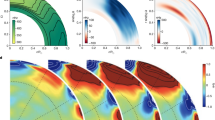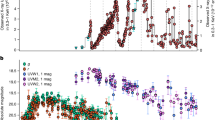Abstract
Hercules X-1 exhibits a 35-day cycle in its X-ray intensity1,2 in addition to its pulsar rotational and orbital periodicities of 1.24 s and 1.7 days respectively. The effects of X-ray heating on the companion are visible throughout the 35-day cycle3, suggesting that the observed intensity modulation is caused by periodic blocking of the line of sight to the pulsar. We report here observations made with the EXOSAT Observatory between 1983 June and August that failed to detect the expected 35-day variation in X-ray intensity, although low-level extended X-ray emission was seen. Models where the obscuring of the pulsar is caused by a processing tilted accretion disk have been proposed4–9, although the physics of the tilted disk are not clear10. Alternatively, wave-like thickenings of the accretion disk have been proposed11 to account for the observed modulation. Our EXOSAT observations suggest that a temporary change in the disk structure may have occurred such that the disk was in the line of sight throughout.
This is a preview of subscription content, access via your institution
Access options
Subscribe to this journal
Receive 51 print issues and online access
$199.00 per year
only $3.90 per issue
Buy this article
- Purchase on Springer Link
- Instant access to full article PDF
Prices may be subject to local taxes which are calculated during checkout
Similar content being viewed by others
References
Tannanbaum, H. et al. Astrophys. J. 174, L143–L149 (1972).
Giacconi, R. et al. Astrophys. J. 184, 227–236 (1973).
Boynton, P. E., Canterna, R., Crosa, L., Deeter, J. & Gerend, D. Astrophys. J. 186, 617–624 (1973).
Crosa, L. & Boynton, P. E. Astrophys. J. 235, 999–1015 (1980).
Katz, J. I. Nature 246, 87–88 (1973).
Roberts, Wm. J. Astrophys. J. 187, 575–584 (1974).
Petterson, J. A. Astrophys. J. 218, 783–791 (1977).
Gerend, D. & Boynton, P. E. Astrophys. J. 209, 562–573 (1976).
Levine, A. M. & Jernigan, J. G. Astrophys. J. 262, 294–300 (1982).
Pringle, J. E. in Accreting Neutron Stars (eds Brinkman, W. & Trümper, J.) 150–155 (Max–Planck-Institut für Physik und Astrophysik, München, 1983).
Meyer, F. & Meyer-Hofmeister, E. Astr. Astrophys. 140, L35–L38 (1984).
Taylor, B. G., Andresen, R. D., Peacock, A. & Zobl, R. Space Sci. 30, 479–494 (1981).
Nagase, F. et al. Am. Inst. Phys. Conf. Proc. (ed. Woosley, S.) 115, 131–133 (1983).
Pravdo, S. H. et al. Astrophys. J. 225, L53–L58 (1978).
Parmar, A. N., Sanford, P. W. & Fabian, A. C., Mon. Not. R. astr. Soc. 192, 311–318 (1980).
Jones, C. & Forman, W. Astrophys. J. 209, L131–L135 (1976).
Turner, M. J. L., Smith, A. & Zimmermann, H. U. Space Sci. 30, 513–524 (1981).
Trümper, et al. IAU Circ. No. 3923 (1984).
Giovannelli, F., Kurt, V., Sheffer, E. & Bisnovatyj-Kogan, G. S. IAU Circ. No. 3924 (1984).
De Korte, P. A. J. et al. Space Sci. 30, 495–511 (1981).
Deeter, J. E., Boynton, P. E. & Pravdo, S. H. Astrophys. J. 247, 1003–1012 (1981).
Davison, P. J. N. & Fabian, A. C. Mon. Not. R. astr. Soc. 178, 27p–29p (1974).
McCray, R. A. et al. Astrophys. J. 262, 301–307 (1982).
White, N. E. et al. Astrophys. J. 247, 994–1002 (1981).
White, N. E. & Holt, S. S. Astrophys. J. 257, 318–337 (1983).
McCray, R. & Hatchett, S. Astrophys. J. 199, 196–205 (1975).
Begelman, M. C., McKee, C. F. & Shields, G. A. Astrophys. J. 271, 70–88 (1983).
Jones, C. A., Forman, W. & Liller, W. Astrophys. J. 182, L109–L112 (1973).
Hudec, R. & Wenzel, W. Bull. astr. Insts Csl. 27, 325–335 (1976).
Delgado, A. J., Schmidt, H. U. & Thomas, H. C. Astr. Astrophys. 127, L15–L16 (1983).
Thomas, H-C., Africano, J., Delgado, A. J. & Schmidt, H. U. Astr. Astrophys. 126, 45–50 (1983).
Middleditch, J., Pennypacker, C. R. & Burns, M. S. Astrophys. J. 274, 313–326 (1983).
Author information
Authors and Affiliations
Rights and permissions
About this article
Cite this article
Parmar, A., Pietsch, W., McKechnie, S. et al. An extended X-ray low state from Hercules X-1. Nature 313, 119–121 (1985). https://doi.org/10.1038/313119a0
Received:
Accepted:
Issue Date:
DOI: https://doi.org/10.1038/313119a0
This article is cited by
Comments
By submitting a comment you agree to abide by our Terms and Community Guidelines. If you find something abusive or that does not comply with our terms or guidelines please flag it as inappropriate.



